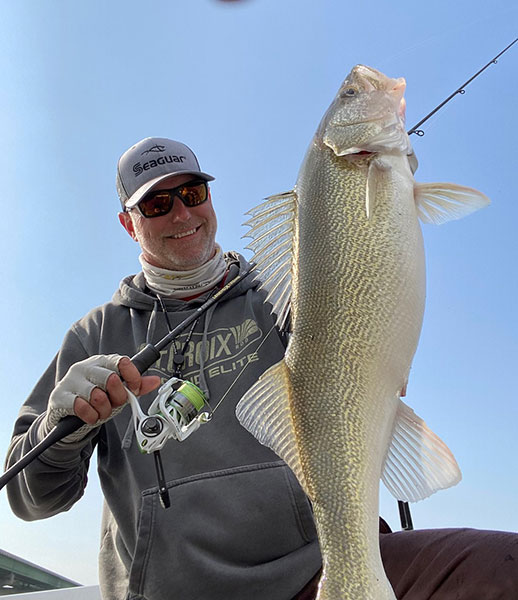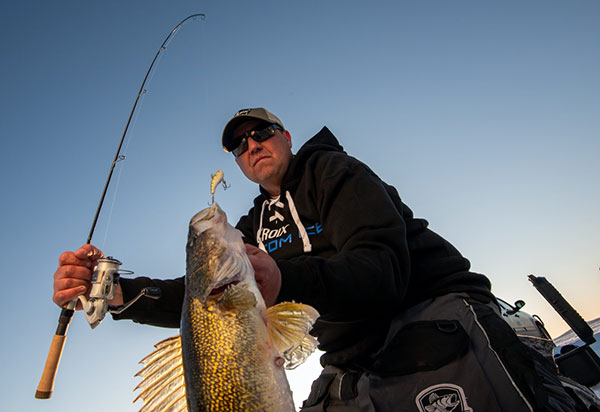Springtime has arrived throughout all but the uppermost reaches of North America, ushering in some of the best angling of the year for everything from perch to pike.
It’s an exciting time for all anglers, but particularly so for anyone targeting mobs of migrating walleyes headed to their predictable pre-spawn and spawn locations. This game is played wherever walleyes are found, but the big-league action takes place in a handful of premier systems. Walleye factories like the Mississippi River, Lake Erie and the Detroit River, Saginaw Bay in Michigan, the Missouri River, Wisconsin’s Green Bay – including the Menominee and Fox Rivers – and Northern Minnesota’s Rainy River represent a few of the premier arenas.
We asked two top walleye guides, Brian Bashore and Tony Roach, to share their favorite presentations for targeting springtime ‘eyes.
Brian Bashore
 Brian Bashore
Brian Bashore
The Missouri River is prolific walleye water. Just ask Sioux Falls, South Dakota NWT tournament pro and guide, Brian Bashore. The St. Croix pro-staffer and co-owner of The Walleye Guys Guide Service says the mighty Mo near Chamberlain, South Dakota is the place to be once the ice clears from the river.
“There’s about a five-mile section of the river in Chamberlain that’s loaded with rocks and prime spawning habitat,” Bashore says. “The main channel loads up with males first, and as the weather warms they start sliding up shallow. This area of the river stays hot from the pre-spawn – which can start as early as late February through mid-March – all the way through the post-spawn period.”
Bashore says guides and other anglers in the know start the early season by dredging the main river channel with heavy jigs or bottom-bouncer rigs. “A lot of fish are caught in 20-30 feet of water out in the main channel early,” he says, adding that dragging a bottom-bouncer rigged with a live minnow is one of the better ways to target them. “You’re pretty much just drifting or slipping with the current, moving along anywhere from around .5 to 1.2 MPH. I’ll often drag a bottom bouncer rig because it keeps the minnow in the strike zone just above the bottom, and you don’t foul your hook with the slime that collects on the bottom over the winter. I’m typically spooled up with 15-pound Seaguar Smackdown braid and fishing a 10-pound Seaguar Gold Label fluorocarbon leader.”
Bashore prefers a St. Croix 7’ medium-heavy power, moderate action BOUNCE-N-TROLL casting rod for bottom-bouncer duty. “This particular length, power and action is ideal because that rod is already under load when it’s dragging the rig. The moderate action soaks up the energy of the strike and also compensates for lack of stretch in your braided mainline and fluoro leader.”
Bashore says he'll also drop and drag a heavy jig tipped with a minnow. “Depending on wind and current, there’ll be times when you need a half-ounce jig to stay in the zone when fishing vertically but you should use as light a jig as you can get away with,” he advises. “I like a Northland Fireball Jig or some other kind of stand-up-style jig with a longer hook shank to keep the slime off the bait. I want a shorter rod for vertical jigging with an extra-fast tip. I’ll match the power of the rod to the weight of the jig, but the St. Croix Avid Walleye ASWS63MXF is a great all-around choice for anything from 1/8 to ½ oz. I’ll match that rod with a 2500-size spinning reel spooled with 10-pound braid and the same 10-pound Gold Label fluoro leader.”
While the river channel is a numbers game in the pre-spawn period, Bashore says he actually prefers fishing shallower. “You’ve really got to sort through a lot of small fish to catch any weight out there. A lot of folks love numbers, but I’d rather target bigger fish,” he says. “Once the water starts to warms up in the shallows, the bait pushes in and a number of the walleyes follow. More and more fish come into the shallow rocks as the spawn gets closer. Even when other anglers are catching tons of fish out deep, I know I can catch larger fish in 3 to 12 feet.”
Bashore uses a combination of vertical jigging and pitching when fishing shallow, typically employing 1/8 to ¼-ounce jigs tipped with minnows or 3” plastics. “It’s hard to beat a straight white Berkley Gulp 3” minnow or a 3” Z-Man MinnowZ paddletail,” he offers.
Bashore keeps rigging simple, pairing both rods with 10-pound Smackdown braid and a two-to-three-foot 10-pound Gold Label fluoro leader. “Even when the water isn’t particularly clear, you need the abrasion resistance of that fluoro leader because of all the rocks. When I’m guiding, I also like to use the hi-vis green color Smackdown braid because I can often see when my clients get a strike.”
Bashore says once the spawn kicks in, all the action moves shallow in a relatively short section of river right in Chamberlain. He says that’s a great time to connect with big spawners on crankbaits. “These fish are hungry for calories, so I’m throwing a lot of shallow Shad Raps and Rattle Traps on 15-pound fluoro,” he says.
Tony Roach Tony Roach
Tony Roach
Tony Roach, owner of Roach’s Guide Service in Northern Minnesota, spends ample time guiding walleye anglers on Mille Lacs, but frequently travels to experience the epic spring walleye runs at places like the Rainy River at Lake of the Woods, as well as around Green Bay.
Roach says Rippin’ Raps and Jigging Raps are two of his favorite lures for springtime walleyes. “They’re a couple of my go-to techniques and tend to be the first baits I tie on in the spring – even with water temperatures as cold as the upper 30s or lower 40s,” he says.
Roach says fishing a Rippin’ Rap can be as physically demanding as it is productive. “You’re basically ripping it up and and letting it fall. I call it puppeteering… ripping or lifting with an erratic snap then walking it back down,” he says. “You can quickly experience a lot of hand and wrist fatigue if you don’t have the right rod with the proper grip and blank.” Roach says the 7’1” medium power, fast action RIP-N-RAP models in St. Croix’s Avid Walleye, Eyecon, and Legend Tournament Walleye series takes the fatigue out of the equation.
Roach uses a braided mainline attached to a fluorocarbon leader when fishing Rippin’ Raps. “It’s still a crankbait, so you don’t want an extra fast action, but you do want enough tip to feel what the lure is doing. The 7’1” length is ideal for casting and pitching these baits and working them effectively,” says Roach. “The medium power and fast action loads up really nicely when a fish hits, handling those big head shakes and runs and darts to the side on unforgiving braided line, even in deep water. Too much power is a potential problem when it comes to keeping fish hooked, and this rod has just the ideal amount while feeling exceptionally light, crisp, and sensitive. Even when I’m fishing forward-facing sonar, I can feel the bite before I can confirm the eat on the screen.”
Roach says fishing Jigging Raps is similar to Rippin’ Raps, but with some subtle differences. “Jigging Raps have become very popular with walleye anglers over the past five years, which prompted St. Croix and I to develop our medium power, moderate-fast action JIG-N-RAP rods,” Roach says. “Walleyes love Jigging Raps, but the knock was you expected to lose a lot of fish because you’ve got smaller hooks on a bait that weighs a lot for its relatively small size. Length and power are the same as on the RIPPIN RAP models – 7’1” medium – but we slowed the action a bit to moderate-fast (in order to create even more forgiveness for those heavier baits with smaller hooks. Like the RIP-N-RAP rod, the 71MMF JIGGING RAP model is also available in all three of St. Croix’s technique-specific walleye series, including all-new Avid Walleye.”
Roach uses the same braid and fluoro combo as he employs for Rippin’ Raps. “It’s usually six-to-ten-pound-diameter braid with a short, eight-to-12-pound fluoro leader. I can feel everything, including when my jig gets fouled,” Roach says. “You lose that feel with mono.”
“I pitch on a lot of fish with forward facing sonar,” Roach says. “Less than 25 feet generally… steep breaks, wind-blown points… anywhere fish are relating to structure… maybe even a big sand flat. You can see them and hunt them down with forward-facing sonar. It’s amazing how many fish chase the bait while it is suspended, then it comes down to adjusting to trigger a strike. You’ve got a front-row seat, so watch how they respond and learn a lot about their mood in real time.”
Roach rigs his pitching rod with six or ten-pound-diameter braided mainline spooled on a 2500-size spinning reel. He uses a short section of eight to ten-pound fluorocarbon leader. Beyond those basics, a few key variables determine Roach’s assault. “Bottom composition usually dictates what I’m pitching, and depth and cover dictate the size of my jig. The new Avid Walleye ASWS68MXF is the ideal forward-facing sonar rod and allows me to feel everything – even the braid jumping on the fall,” he says. “Wind and waves can rob sensitivity, but this rod has it in spades. I can feel everything all the time. It also has the ideal combination of power and backbone, and that extra-fast tip is important for the hookset.”





